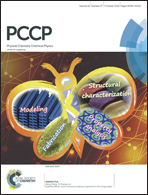Stability and binding interaction of bilirubin on a gold nano-surface: steady state fluorescence and FT-IR investigation†
Abstract
A gold nanoparticle exhibits strong absorption and emission due to its unique physical geometry and surface plasmon resonance phenomena. A further modification with organic molecules makes it more appropriate for biological applications. The current manuscript illustrated the optical behavior and stability of bilirubin (BR) coated gold (AuBR) nanoparticles, using BR itself as a reducing agent. In addition, FT-IR and steady state fluorescence measurements were performed to illustrate the binding interaction of BR with the Au(III) ion and the nanoparticles. BR showed a strong affinity towards Au(III) and the measured binding constant was ∼4.3 × 105 M−1. It caused reduction of the Au(III) ion and rendered the formation of cubic face centered AuBR nanoparticles, which were ∼20 nm in diameter. The particles were stabilized as BR was bound to the gold nanoparticle surface, which was confirmed by FT-IR measurement. An intense carboxyl C![[double bond, length as m-dash]](https://www.rsc.org/images/entities/char_e001.gif) O stretching vibration at 1695 cm−1 was observed for the BR powder but was absent for the AuBR nanoparticles. However, two weak bands at ∼1563 and 1391 cm−1, presumably due to the asymmetric and symmetric stretching vibrations of the carboxylate form (COO−), were found for the AuBR nanoparticles. A stretching vibration of lactam C
O stretching vibration at 1695 cm−1 was observed for the BR powder but was absent for the AuBR nanoparticles. However, two weak bands at ∼1563 and 1391 cm−1, presumably due to the asymmetric and symmetric stretching vibrations of the carboxylate form (COO−), were found for the AuBR nanoparticles. A stretching vibration of lactam C![[double bond, length as m-dash]](https://www.rsc.org/images/entities/char_e001.gif) O appeared at 1645 cm−1 for BR and the band was shifted to 1647 cm−1 for the AuBR nanoparticles. The stretching modes of pyrrole N–H and lactam N–H were detected at 3406 cm−1 and 3267 cm−1, respectively, for BR. However, the pyrrole N–H band shifted to 3446 cm−1 and became broader for the AuBR nanoparticles. The observed blue shift in the lactam C
O appeared at 1645 cm−1 for BR and the band was shifted to 1647 cm−1 for the AuBR nanoparticles. The stretching modes of pyrrole N–H and lactam N–H were detected at 3406 cm−1 and 3267 cm−1, respectively, for BR. However, the pyrrole N–H band shifted to 3446 cm−1 and became broader for the AuBR nanoparticles. The observed blue shift in the lactam C![[double bond, length as m-dash]](https://www.rsc.org/images/entities/char_e001.gif) O and N–H vibrations of the AuBR nanoparticles indicated a weakening/absence of internal hydrogen bonds between the carboxyl groups and the four N–H bonds in the BR moiety. The binding of BR to the surface provides great stability to the nanoparticles, which remained monodispersed in the large pH range (pH 4 to 12) for more than a month. However, under acidic pH conditions the particles associated to form bigger particles and the plasmon resonance band shifted as they grew; the plasmon resonance band shifted from 525 nm (at pH 7.0) to 555 nm (at pH 3.0). The particles also remained stable in the presence of a higher concentration of salt (KCl and NaCl) in the dispersing media.
O and N–H vibrations of the AuBR nanoparticles indicated a weakening/absence of internal hydrogen bonds between the carboxyl groups and the four N–H bonds in the BR moiety. The binding of BR to the surface provides great stability to the nanoparticles, which remained monodispersed in the large pH range (pH 4 to 12) for more than a month. However, under acidic pH conditions the particles associated to form bigger particles and the plasmon resonance band shifted as they grew; the plasmon resonance band shifted from 525 nm (at pH 7.0) to 555 nm (at pH 3.0). The particles also remained stable in the presence of a higher concentration of salt (KCl and NaCl) in the dispersing media.


 Please wait while we load your content...
Please wait while we load your content...